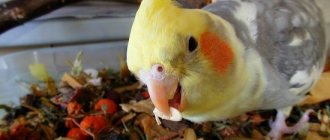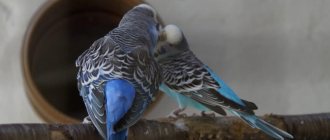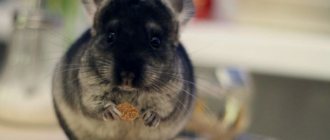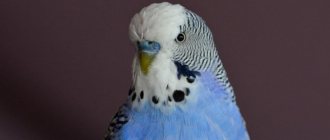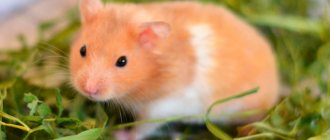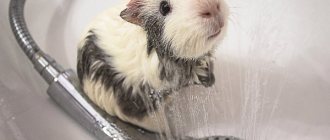The intricacies of breeding cockatiels are not known to everyone, and therefore novice breeders often experience failure. To deal with this issue, it is necessary to prepare well and study the behavioral characteristics of parrots and their needs.
We will learn how to properly prepare for mating birds, not make a mistake in choosing a male and female, and correctly organize the breeding of cockatiels.
general description
A medium-sized parrot from the Cockatoo family weighs 100 g. The body size is about 30 cm, the tail length reaches 15 cm, the wingspan is 40 cm. The beak is small, but quite powerful. A distinctive feature of cockatiels is a high crest on the head.
Natural coloring is not very bright; males look somewhat more colorful than females. Chicks at a young age have the same faded coloring as females. Only when they reach the age of puberty do males acquire their characteristic plumage. Usually changes begin to occur from 6 months of age.
Corellas reproduce well in captivity; artificially bred parrots have a wide variety of plumage color options. The most common mutation is lutino. Individuals of this species are yellow in color. They have red eyes and orange cheeks.
Cockatiels live only in Australia. These birds are monogamous. Their breeding season coincides with the rainy season and lasts from October to December. Parrots make their nest in the hollow of a dead tree at a height of 2 m above the ground. The female lays 4 to 7 eggs, one egg per day.
Both parents are equally involved in incubating eggs and feeding chicks. The chicks hatch after 17-23 days and are completely helpless. After 5 weeks, the chicks leave the nest. They reach puberty at 6-11 months.
In the wild, cockatiels live 12-15 years. If kept at home, a parrot can reach the age of 25 years with proper care.
Feeding the chicks
For three to four days, the female feeds the chicks with a yellowish-white liquid - crop milk. After this, the cockatiel begins to give them semi-digested food received from the male.
If the birds, due to fatigue and lack of parental instinct, did not feed the chicks, you will have to help them.
Feed the chicks baby formula every two hours. It should be liquid and heated to a temperature of thirty-five degrees. For convenience, use a syringe without a needle.
After a week, start feeding the chicks every three hours. When they are two weeks old, add well-cooked liquid porridge made from crushed millet to the baby food. Increase the amount of food so as not to feed babies at night. When the chicks are a month old, start feeding them grain mixture from a spoon five to six times a day until they begin to eat on their own.
If you have already bred cockatiels, please share your experience with us. Perhaps you have something to add.
If you liked the article, please like it.
Features of behavior
When planning to breed cockatiels at home, pay attention to the behavioral characteristics of these parrots. The emotions they experience are clearly demonstrated by the parts of the bird’s body:
- Excitement, alertness - the crest stands upright, eyes wide open.
- Aggression, preparation for an attack - the crest is slightly tilted and pressed to the head, the pupils are dilated, the feathers are ruffled, the tail is loose. The bird clicks its beak and flaps its wings.
- Playfulness - the crest is held straight, lightly touching the back, eyes narrowed.
Parrots have a harsh and unpleasant voice. The more excited the bird is, the higher the voice.
If a cockatiel hisses, it is a sign that it is preparing to attack. A parrot reacts this way if it believes that an attempt is being made to take over its home. You should not stick your fingers between the bars; cockatiel bites are very painful.
Corella is sensitive to affection. She enjoys scratching her head and ruffling the feathers on the back of her head.
Cockatiels are shy. When experiencing stress, untamed parrots can become aggressive when given a new owner. It is better to buy birds from a nursery or from trusted breeders. It is not recommended to adopt an adult, unsocialized bird: it will not be able to get used to its owner and will cause him a lot of trouble.
Determining the sex of a parrot
At first glance, males and females are very similar. Those ignorant of this issue can easily confuse them. But, there are signs that unmistakably determine the sex of a bird. The main thing is to know where to look.
By the crest
Take a close look at the bird's crest. If it is narrow, then this is a male. Females have wide crests covering the entire forehead. But there are exceptions. Determining the width of the crest requires a little experience.
It is also worth noting the number of long feathers. Boys have no more than 3 of them, but females can have up to 6 of them. A greenish tint to the long feathers of males is also noted.
By plumage
The color of the plumage can determine the sex of any species of parrot. In cockatiels, differences in plumage color have their own characteristics:
- Males - the plumage of the head has a yellow tint, the cheeks are pink.
- Females - the head has a gray tint of feathers, the cheeks are also pink, but not as bright as those of males.
Birds receive such plumage only after the first molt, which occurs at approximately 7 months. Before this period, it is almost impossible to determine the sex of a bird by plumage.
It is worth noting that the above color combinations of parrot feathers are characteristic only of “purebred” cockatiels. If there was crossing of species, then the color of the bird will be individual.
According to body shape
Not only in plumage do males surpass females in beauty, but also in body shape. Females have a small hump on their back between the wings. Males don't have this.
Their wings are more graceful and pointed. In comparison, males try to look stretched and cheerful. When the females are calm, they sit with a little bristling.
Take a closer look at the belly plumage; females have a small parting there. It is also worth focusing on the placement of the paws. In girls they are more widely spaced than in males, which is explained by their physiology.
The tails are also different. In males they are pointed, beautiful and well-groomed. When females have tails that are slightly sloppy and fluffy.
DNA test
If none of the above signs can accurately determine the gender of the cockatiel, you can use medical services. A DNA test can determine the sex of a parrot with 98% accuracy. Not all cities conduct such tests. And the price tag for them is not low - from 15 dollars.
To do such an analysis, you need to collect 5-6 isthmus of a feathered pet. Please note that they must be taken from the feathers and must not be lost. The feathers must be sent to the laboratory no later than the second day of collecting feathers, otherwise the test will not be accurate.
If there is no specialized laboratory in your city, you can send biological material for analysis by mail. Again, consider the time frame within which feathers need to be submitted for analysis.
Breeding
Breeding cockatiels is not difficult; As soon as parrots are 6 months old, they are already able to reproduce. But it is better not to subject a fragile organism to such a test and give the chicks the opportunity to grow up to one and a half years old.
In nature, parrots breed in the fall. At home, you can encourage cockatiels to mate by artificially creating suitable conditions for them; for this you need to:
- Find compatible partners.
- Ensure correct lighting conditions.
- Offer complete food.
- Place a nest in the cage.
It is advisable to purchase a spacious tall cage of rectangular or square shape. To breed a cockatiel at home, you need to provide a pair of parrots with a large cage, at least 70x70x150 cm.
Matching
Cockatiels are monogamous and by nature choose a mate for life. To breed in captivity, they also need stable, strong relationships with others and mutual sympathy. The breeder must give the birds a choice: an aviary containing several males of different sexes is suitable for this. This way, it's more likely that you'll get a compatible pair in no time.
Good breeding offspring of roosters is obtained by following several rules:
Physical health
When choosing breeders, you should carefully monitor their emotional and physical state. The reproductive capacity of the cockatiel is maintained despite the disease. But it is impossible to predict which chicks will appear in a weakened bird. Injured, melting or sick parrots should not be allowed to mate.
Carefully. An obese bird should first be brought back to normal before being prepared for breeding. An overweight parrot gets tired quickly and cannot sit on eggs in one position for a long time.
Not related
Breeding closely related cockatiels is only justified if the goal is to preserve the characteristics of the mutation (for example, lutino). Inbreeding, the breeding of related correlates, has negative consequences. Related individuals produce offspring with external defects and deviations in basic functions:
Chicks grow slowly as they age. Such chicks rarely give birth to viable parrots.
Suitable age
Physically and functionally, males are ready for breeding at the age of 9-10 months. Until then, their reproductive system matures, but in reality, correlates under one year of age remain infants. They do not want to take care of their chicks, because they themselves are actively growing and spending their vital resources.
Breeding young correls at home is not always successful: the female abandons the brood, and the raised chicks often die. Carefree parents do not have protective skills, and the maternal instinct is not yet sufficiently developed. There is a high probability that the eggs themselves are unfertilized. Problems arise with immature females: inexperienced ones cannot push out a stuck egg.
At the age of one and a half to two years, breeding is most successful. By that time, the pair of cockatiels will be sufficiently prepared, their bodies will be stronger. Childish playfulness will be replaced by calm maturity, the birds will feel the need to continue the family tree.
On the fields! The best producers are considered to be cockatiels from 2.5 to 5 years old. Later, sexual function gradually decreases and adult parrots become completely infertile.
Compatibility issues
When a pair of opposite-sex cockatiels live together from a young age, and they have no alternative to meeting other partners, their friendships can gradually turn into marital ones. The resulting mutual interest will clearly manifest itself. The birds will sit side by side on a perch and gently touch each other’s feathers with their beaks. The male's readiness to mate is demonstrated by the increased intensity of his chants.
If your pet is raised alone and aggression occurs when a foreign parrot is introduced between the cockatiels, this may be due to increased testosterone levels in the male. A short separation usually solves this problem. If mutual hostility does not go away, you will have to take care of acquiring other marriage partners.
How to choose a mate for your cockatiel
To breed good offspring, you need to choose two healthy parrots. They must be healthy and mature, and not related to each other.
What to feed
When breeding cockatiels at home, parrots are fed well-balanced food. A grain mixture for medium-sized parrots is suitable for this. Additionally, add to the diet:
- grated carrots;
- pieces of cabbage;
- slices of apple, pear;
- plantain seeds;
- dandelion leaves;
- a few drops of vegetable oil;
- sprouted grains;
- honey (2 g 1 time per week);
- boiled egg (2 - 3 times a week, a little).
Honey and butter can be given on a small piece of bread. Birds love to chew on fresh tree branches. The cage must contain special mineral supplements in the form of sand and pebbles.
After the birds settle into the nest for brooding, soft egg food should be excluded from their diet. Its presence stimulates the female to lay more eggs.
When the chicks hatch, the mashed egg becomes their main food and is returned to the feeder. Grown chicks, feeding on their own, switch to the regular diet of parrots.
Parents feed their babies by regurgitating food directly into their beaks. Chicks can be taken from their parents for artificial feeding when their eyes open. This usually happens on days 10–12. The “foster babies” are fed liquid warm porridge made from infant formula. You can also feed “natural animals” in order to accustom them to human hands.
What to do if a cockatiel laid an egg without a male
Frequent clutches are harmful to the health of the parrot. In order not to weaken the bird, the house is removed from the cage along with the grown chicks and the female is given a rest for 4–5 months.
It happens that a cockatiel lays eggs without a male. The bird's body is programmed for this by nature. However, such eggs are not fertilized; they are empty inside.
Most ornithologists consider cockatiels to be unique birds. Beginning breeders often ask what to do if a cockatiel lays an egg without a male. It all depends on your plans for the future:
- If you plan to breed birds and buy a male, there is no need to remove the empty egg. The bird will sit for the required period, this will strengthen its maternal instinct. But after 3 weeks the egg needs to be thrown out.
- If the owner of the cockatiel does not plan to select a male, the laid egg should be removed immediately. The female will be sad for a while, but will quickly calm down. Perhaps she will repeat the laying. Repeated removal of the egg may destroy its maternal instinct, and the bird will become useless for reproduction.
You can help the female “refuse” the next clutch by reducing daylight hours and reducing vitamin supplements in the diet. It is better to discuss this issue with a veterinarian, since a lack of calcium causes the development of osteoporosis and hypocalcemia in the cockatiel.
Breeding cockatiels is not only exciting, but also profitable. Smart, healthy, promising birds from experienced breeders are highly valued. But getting high-quality offspring requires a lot of effort, special knowledge, and attention to your feathered charges.
If you create comfortable conditions for exotic birds, feed them properly, and keep them clean, they will delight their owners with funny games, ringing trills, as well as healthy and beautiful offspring.
Requirements for daylight hours
Long daylight hours stimulate parrots to reproduce; for cockatiels it should be at least 16 hours. Before this, the birds are kept on a shortened day for a month, its duration is 8 - 10 hours. During this period, parrots must undergo molting, their gonads are activated.
The required length of daylight can be ensured with the help of additional sources of artificial lighting and dense material thrown over the cage. The parrot needs to add more “day” gradually, 10 minutes every day. Too sudden a change in conditions can negatively affect his sexual function.
Comfortable indoor conditions for the breeding pair are maintained with a constant air temperature of 18–20 °C and a humidity of 50–60%.
Conditions and breeding period for cockatiels
For successful breeding of cockatiels, a suitable period is chosen and comfortable conditions are created for breeding future offspring. Parrots breed at any time of the year. But it is better to breed them from May to October.
cockatiel nest
House
You can make a house with your own hands or buy it at a pet store. The nest should be 40 to 45 cm long, 40 to 45 cm wide, 35 cm high. The diameter of the tray is approximately 8 cm. A mound of sawdust is made at the bottom of the nest (height 3 to 4 cm). They give preference to deciduous trees.
Place in the cage
The house is hung from a cage or placed in an enclosure. Do not place the nest high so that the chicks do not fall. The best option would be a folding or removable lid. This will allow you to inspect eggs, chicks and clean the nest.
Sawdust
In the absence of deciduous sawdust, pine sawdust is purchased. Before use, pour boiling water over and dry. 1 teaspoon of dry chamomile added to sawdust will prevent the occurrence of parasitic diseases. Nothing is placed under the perch to prevent the parrots from being injured.
Temperature and humidity levels
The optimal temperature is considered to be from 20 to 25 degrees Celsius. The humidity level should be between 60 and 70%. In winter, chicks need artificial lighting. Increase daylight hours daily by half an hour.
Cockatiel nutrition during the breeding period
For 3 months before breeding, it is necessary to add a wet nutrient mixture and vitamins and minerals to the food.
| The following are welcome in the diet: | During the incubation period add: |
|
|
Arrangement of the nest
A nest placed in a cage serves as a signal to encourage parrots to mate. This process usually takes about a week, but there may be exceptions. A special box is used as a nesting box; it can be bought in a store.
By the behavior of the parents, you can accurately determine when eggs will appear in the nest. The birds alternately perform the duties of a hen: during the day the male takes care of the eggs, at night the female replaces him at post. After 21 days from the moment of laying, the chicks will begin to appear.
Laying and incubating eggs
Immediately before mating, the behavior of the male changes noticeably - he becomes very affectionate, emits inviting calls, sings songs, taps his beak on the floor of the cage, minces and with spread wings courtes the female, invites her into the nesting house and tries in every possible way not to let her out.
The female begins to behave like the male: she spins around him and pecks at the perch. When there are other females in the cage, it can show aggression. The mating period does not last long, and after 8–10 days the first egg may appear in the nesting sawdust.
The next ones are postponed at intervals of 2-3 days. The maximum number of white eggs in a clutch is 5–6 pieces, rarely 7. Hatching is carried out by cockatiels one by one. Closer to the time the chicks appear, only the female is involved in the main process, and the male performs the functions of a guard and breadwinner.
Find out what to do if your cockatiel starts laying eggs.
Hatching time averages 20–23 days. During this period, it is very important to maintain optimal air temperature and humidity levels in the common room with the house.
What types of cockatiels are there?
The natural color of these parrots is represented by a gray body, yellow head and bright orange cheeks. During artificial breeding, new, brighter colors were developed. Now you can find cockatiels with the following colors from breeders:
- White. There are two types: albino and just white. Differences in eye color. Albinos will have red eyes, while whites will have black eyes. Let's allow a light cream shade of plumage. The head and crest remain yellow.
- Whitewing. This color is characterized by white flight feathers, and the main feathers remain gray.
- Light grey. Somewhat lighter than usual gray individuals. The yellow head and crest are preserved.
- Pearl grey. In this color the feather has uneven pigmentation. The very edge is a rich gray color, and the middle of the feather is white. You can find individuals that have a cinnamon or yellow tint instead of white. Only females retain this unusual coloration for their entire lives. Males change color after molting.
- Cinnamon. The main plumage can take on various shades of brown.
- Dark yellow. In this case, the color varies from light cream to dark yellow.
- Lyutino. This color implies a yellow body color with white spots on the wings. The cheeks are bright orange.
- Blackwing. Representatives of this color have a back and tail that are much darker than the main gray color of the body. The wings are also darker and have white spots.
- Black. The entire cockatiel is a rich dark gray color. The breast is almost black in color; there are light spots on the wings. The cheeks are dark orange and may have a few black feathers.
The most common colors: gray and lutino - Sheki or spotted. The main shade of these representatives is gray. There are many white spots on the wings. The head is white, the tail should be white-yellow. Spotted cockatiels have a subspecies - the harlequin. In such birds, only the wings remain gray, the head and crest are yellow, and the main part of the feathers is white.
By crossing different colors of cockatiels, unusual and original colors are increasingly being obtained. But most of them are still gray. This coloring is considered natural. The brightest colors are obtained by crossing spotted representatives with other pigment carriers.
Taming the cockatiel
Usually taming does not require anything special or complex skills. If the bird was purchased from a breeder, then it is socialized from the beginning. Individuals from pet stores may be a little less attuned to humans, but this can also be resolved within a few weeks.
At first, just stay next to the nymph's cage for 20-30 minutes a day and talk to her . Increase your communication time every day. If there is no negative reaction and the bird approaches you, give it a treat through the cage. After a few days, open the cage and stick a tasty treat nearby so that the nymph becomes interested and comes up to take it. Then place the treat on your open palm so that the bird climbs onto your hand. When the cockatiel climbs onto your hand without fear, turn your hand so that it is comfortable for her to sit on your finger and pull the parrot out of the cage. This is how you can start taming your parrot.
Now you can pet and “sniff” your pet. You don’t have to worry about what cockatiels love. They love affection, attention and treats very much. The Corella parrot is not particularly demanding in terms of care, maintenance and feeding. But he is very demanding in communicating with his new family. She will need at least an hour of your attention every day in order not to lose the level of socialization.
You can teach a cockatiel to sing beautiful melodies
These birds are very good at learning various tricks and human speech. Males do most of the talking, whistling and singing. Girls are more modest and silent, but a lot depends on how often you talk to her. Any animal is set up for dialogue, and the more you talk to it, the more it will want to answer you.
The basis of proper training is praise and affection. Never swear at a bird. This will only scare her, but she will not understand what exactly upset you. Repeat the desired words or tricks systematically for 20-30 minutes a day. Immediately positively encourage any fulfilled desire - praise with words, stroke, give a treat.
When practicing commands, always accompany the action with one specific word. Let’s say, when learning to sit on a finger, say “sit,” move your finger under the paws (this is how the cockatiel will reflexively move its paws to the finger) and immediately give it a treat.
Why doesn't the parrot hatch eggs?
The presence of the nesting house in the cage should stimulate the female budgerigar to begin laying eggs. In the worst case scenario, the female's ovaries do not work, so she cannot have chicks. ... The female budgerigar laid an egg, but does not hatch it.
Interesting materials:
Where is the C ProgramData folder? Where is the AutoCAD templates folder? Where is the brake pedal on an automatic? Where is the pink sand beach? Where is the Borodino battlefield located? Where is the Expression Builder in Access 2007? Where is the Toyota Auris cigarette lighter fuse located? Where are the tributaries of the Volga? Where is the Business Bonuses section in The Sims 4? Where is the speech center in the brain?

